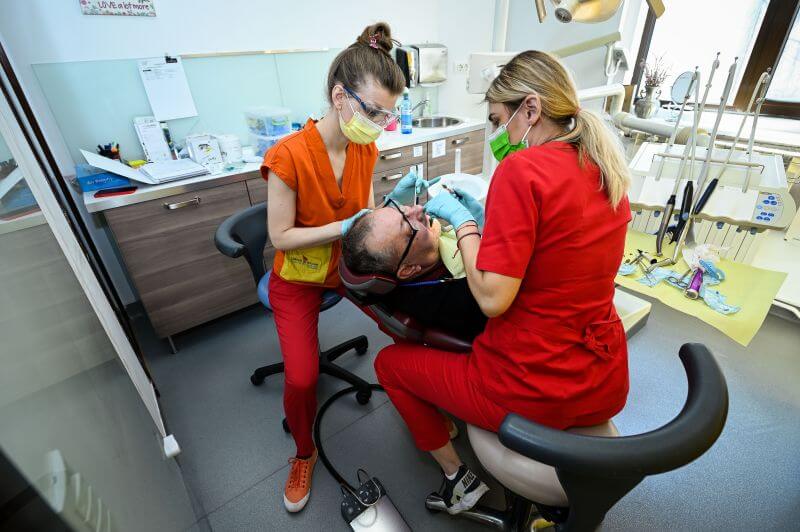Fatete dentare fara slefuire (no prep)

Fatetele se pot aplica prin 2 proceduri, cu slefuirea dintilor, adica cu preparatie, sau fara slefuire („no prep”). Desi exista mai multe tipuri de fatete dentare realizate din compozit sau materiale precum zirconiul sau ceramica (Lumineers, Emax, etc), nu toate fatetele pot fi utilizate oricand si oricum in metoda No Prep.
Cand sunt indicate fatetele „No Prep”?
Daca nu esti multumit/a de culoarea, forma sau marimea dintilor, fatetele fara slefuire iti pot aduce rezultate estetice semnificative fara operatiuni invazive si fara afectarea structurii dentare.
Fatetele NO PREP pot fi potrivite atat adultilor, cat si adolescentilor nemultumiti de culoarea, forma sau marimea dintiilor, dar mai ales celor care au:
- Dinti sparti, ciobiti sau zgariati
- Usoare pete pe dinti sau dinti putin decolorati
- Spatii mai mari sau mai mici intre dinti
- Forme inestetice ale dintilor sau dinti usor nealiniati
- Dinti usor inghesuiti
- Dinti mici
Candidatul ideal
Candidati buni pentru fatele „No prep” din nefericire sunt foarte putini si asta pentru ca pacientul trebuie sa indeplineasca unele conditii stricte precum: ocluzie stabila si echilibrata, igiena foarte buna, sa nu prezinte discoloratii severe, carii sau fracturi dentare.
In concluzie, fatetele dentare fara slefuire No Prep sunt indicate in principal pentru a inchide spatiile dintre dinti si/ sau pentru a modifica forma dintilor, cu respectarea conditiilor de mai sus. Pentru a stabili daca dintii pacientului se preteaza la fatetarea fara slefuire, doctorul stomatolog trebuie sa examineze starea danturii pacientului. Pentru informații suplimentare, accesează pagina noastră despre fațete dentare.
Te confrunți cu probleme dentare greu de gestionat? Nu le lăsa să îți afecteze sănătatea, sună-ne pentru a afla care sunt soluțiile potrivite pentru tine:
0751 051 096, sau completează Formularul de programare, și te sunăm noi!
Materiale utilizate
Fatetele fara slefuire sunt foarte subtiri (au o grosime de mai putin de 0.3 mm), in unele cazuri la fel de subtiri ca lentilele de contact si sunt confectionate din ceramica. De aceea nu necesita indepartare de tesut dentar si se aplica cu ajutorul unui adeziv direct pe dinte. Rezultatul este unul cu aspect natural si foarte apreciat de catre pacienti.
Ceramica Lumineers
In mod obisnuit, fatetele clasice de ceramica (portelan) necesita o slefuire mai mare a dintelui, uneori chiar depasind stratul de smalt, iar acest lucru face ca procedura sa fie ireversibila.
In ultimul timp insa, au aparut noi fatete din ceramica (Lumineers) ce pot fi plasate direct pe smalt sau cu o slefuire minima a acestuia, fara a afecta in vreun fel dentina.
Avantaje
Non – Invazivitate
In procedura „No Prep” nu se frezeaza si nu se modifica suprafata dintilor, acestia ramanand intacti, exact asa cum au fost initial.
Astfel, dupa ce fatelele s-au aplicat este imposibil sa rezulte o sensibilitate a dintilor la alimentatia si bauturile „calde” sau „reci”. Nu exista restrictii si nici efecte secundare, metoda fiind total neinvaziva.
Durabilitate
Adeziunea fatetelor in mod exclusiv pe smalt creeaza o legatura foarte puternica intre suprafata dintelui si fateta, acest proces ridicand semnificativ durabilitatea lucrarii estetice.
Dacă vrei să previi apariția unor probleme dentare în viitor, descoperă mai multe informații despre tratamentele pe care le oferim. Contactează-ne pentru a primi un sfat specializat la telefon
0751 051 096 sau prin Formularul de programare.
Confort maxim
In timp ce fatetele clasice din ceramica necesita injectarea unui anestezic, acest lucru nu mai este necesar pentru fatetele No Prep. Deoarece dintii nu se slefuiesc, nu avem nevoie de niciun fel de anestezic, deci operatiunea este total lipsita de disconfort.
Procedura rapida
Aplicarea fatetelor este rapida, procedura putandu-se realiza in una sau doua sedinte.
Dezavantaje
Incompatibilitate pentru dinti foarte inghesuiti
Fatetele fara slefuire nu pot fi aplicate in cazul dintilor foarte inghesuiti decat dupa ce se urmeaza tratamentul ortodontic de aliniere a dintilor cu aparatul dentar.
Nepotrivire pentru dinti foarte decolorati
Pentru fiecare grad de discoloratie ce necesita mascare, dentistul are nevoie de 0.2 mm strat de ceramica. Teoretic, cu cat dintii sunt mai decolorati, cu atat se adauga mai multa ceramica. Practic, insa, nu se pot adauga mai multe straturi pentru ca fatetele No Prep ar deveni foarte „groase” si dintii inestetici.
Deci, dacă sunteți în căutarea unei soluții estetice rapide și eficiente pentru a obține un zâmbet perfect, fatetele dentare fără slefuire reprezintă o opțiune atrăgătoare. Ele vă permit să vă îmbunătățiți aspectul zâmbetului fără a compromite sănătatea și integritatea dinților.
Dacă ai decis să apelezi la ajutor specializat pentru problemele cu care te confrunți și cauți informații suplimentare despre tratament, ia legătura cu noi: telefon
0751 051 096 sau online prin Formularul de programare

